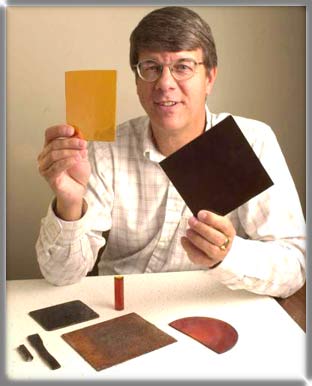Use plastic from corn or beans for making pig feed mills
Iowa State University chemistry professor Richard Larock pulled out a thin, square piece of a neatly labeled bag of what he called plastic made from corn, soybeans and other bio-oils. Putting hard on his hands, he said, this is made from soybean oil reinforced with fiberglass. It is a tough bioplastic that he and his collaborators will use to develop, test and manufacture pig feed mills.
According to Larock, his research topic is partially subsidized with about $ 96,000 from the Iowa Development Value Fund, a state economic development program, and Iowa is considered a major producer of corn, Soy and pork throughout the country. Larock is working with Agvantage, Illinois, a comfortable manufacturing company in Iowa and R3 Composites.

Richard Larock along with bio-plastic pieces made from bio-oil (Photo: Eurekalert.org)
Larock invented and started the process for producing bioplastics from cheap natural oil, which will help create 40 to 80% of plastics. Larock says more plastics have excellent thermal and gasification properties and are good at reducing noise and vibration. It is also very easy to re-create the original shape when heated.
So he is very optimistic about the potential of bioplastics in beneficial applications. This research will create a new technology and expand opportunities for biotechnology and agricultural supplies, reducing dependence on oil, strengthening Iowa's agricultural economy, leveraging patent technology. ISU, bringing new markets to farmers and connecting agricultural product development with sophisticated production skills and knowledge to commercialize these projects.
Ron Hagemann, principal of AgVantage, said: Pig feed blender designs using bioplastics are being elaborated. The design includes radio frequency identification techniques that control and record the habits of each pig. Molds for these mills will be completed by the end of this year and the first models will be available for next spring. If it works well, it will hit the market later this year.
The biggest advantage of these machines is the price of raw materials, corn oil and soybeans are relatively cheaper than petrochemicals and especially needed today when oil prices are rising. Professor Hageman adds that if they can do this, things will be easier later, but Larock is still trying to find agricultural additives for bioplastic production and research into the possibility of drying. How can a cup of the machine be useful for bioplastics?
Anh Phuong
- Technology of corn milk making
- The first transgenic corn was certified for biosecurity
- Video: The most spectacular corn-cutting technology ever seen
- Recognizing 4 genetically modified corn varieties for food
- Argentina successfully invented plastic from corn and cassava
- Admire the exotic polychrome corn in America
- The way to make corn is like a rainbow
- Sweet solutions for plastic garbage
- The reason for eating corn is healthy
- Rushing to buy Laos beans to smoke venom, experts say carefully to avoid
- The secret to deodorizing plastic containers for food
- Drinking corn water, you must know this
 Daily use inventions come from universities
Daily use inventions come from universities Special weight loss device helps prevent appetite
Special weight loss device helps prevent appetite 8 inventors were killed by their own inventions
8 inventors were killed by their own inventions Iran invented a motor car powered by water
Iran invented a motor car powered by water